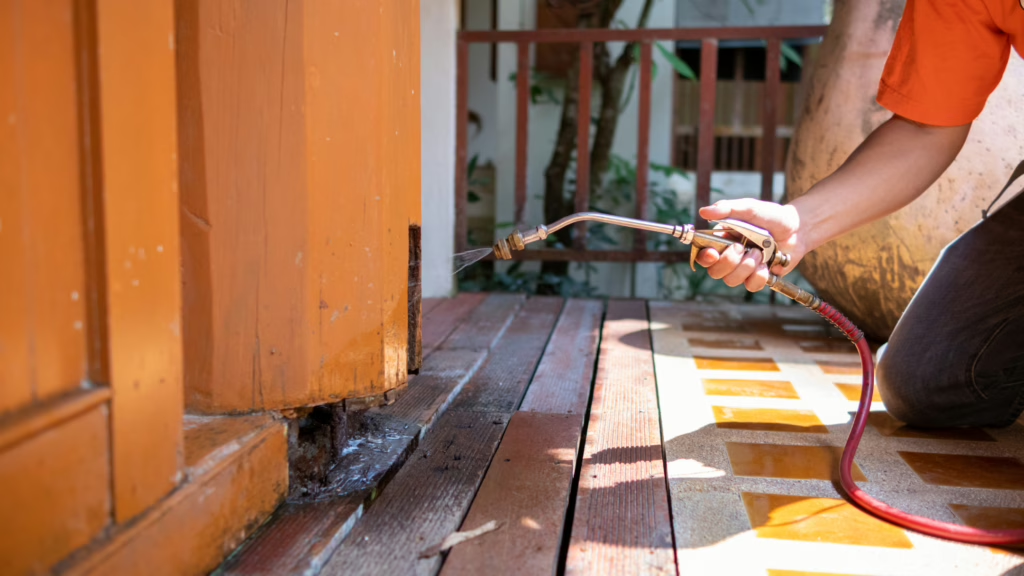Termites are silent destroyers that can cause thousands of dollars in damage before homeowners even notice them. Whether you’re buying a new home or maintaining your current one, regular termite inspections can help prevent costly repairs. Here’s how to check your home for termites before they become a major problem.
1. Understand the Signs of Termites
Before you start your inspection, familiarize yourself with the common signs of termite activity:
- Mud Tubes – Subterranean termites create pencil-sized mud tunnels along walls, foundation, or crawl spaces to protect themselves from open air.
- Hollow Wood – Tap on wooden surfaces. If they sound hollow or feel soft, termites may be eating the wood from the inside.
- Swarmers (Flying Termites) – These winged termites appear in warm weather, often near light sources. Discarded wings near windows or doors are a telltale sign of an infestation.
- Frass (Termite Droppings) – Drywood termites leave behind tiny, wood-colored droppings that resemble sawdust or coffee grounds.
- Warped or Buckling Wood – Termites can cause floors, doors, and walls to warp or bulge, similar to water damage.
- Clicking Noises in Walls – Some termites make faint clicking sounds as they eat through wood.
2. Inspect Your Home’s Exterior
Start your inspection outside your home, as termites often begin their invasion from the soil.
- Foundation & Crawl Spaces – Look for mud tubes along the foundation, walls, and in crawl spaces.
- Wood-to-Soil Contact – Termites thrive where wood meets the ground. Check fence posts, decks, and wooden siding for signs of damage.
- Tree Stumps & Firewood – Old stumps and stored wood piles are breeding grounds for termites. Keep them at least 20 feet away from your home.
- Cracks & Gaps – Check for openings in bricks, siding, or foundation where termites can enter. Seal any gaps to reduce risk.
3. Check Interior Areas
Move inside and look for signs of termites in key areas where they tend to thrive.
- Windows & Doors – Swarmers often enter through windows, and wooden door frames can be a target for termites.
- Basements & Attics – Dark, undisturbed areas with wood are ideal for termites. Inspect wooden beams and stored boxes for damage.
- Flooring & Baseboards – Soft or sagging floors, peeling paint, or small holes in drywall can indicate termites.
- Kitchen & Bathrooms – Since termites are drawn to moisture, check under sinks, near pipes, and around water heaters.
4. Use DIY Termite Detection Methods
If you’re unsure whether termites are present, try these simple tests:
- Flashlight & Screwdriver Test – Use a screwdriver to probe wooden areas. If it pushes through easily, termites may be inside.
- Paper or Cardboard Trap – Place damp cardboard in an area where termites are suspected. If termites are present, they’ll start feeding on it.
5. Call a Professional if You Suspect an Infestation
If you notice signs of termites, don’t wait—contact a pest control professional immediately. A licensed inspector can assess the extent of the damage and recommend treatment options, such as liquid termiticides or bait systems.
Preventing Future Termite Infestations
- Keep firewood and mulch away from your home’s foundation.
- Fix leaks and reduce moisture buildup around your home.
- Seal cracks and gaps in walls, doors, and windows.
- Schedule annual professional inspections for early detection.
Final Thoughts
A termite infestation can go unnoticed for years, but by conducting regular home inspections and knowing the warning signs, you can catch termites before they cause serious damage. If you’re unsure, always seek professional help to protect your home from these destructive pests.
